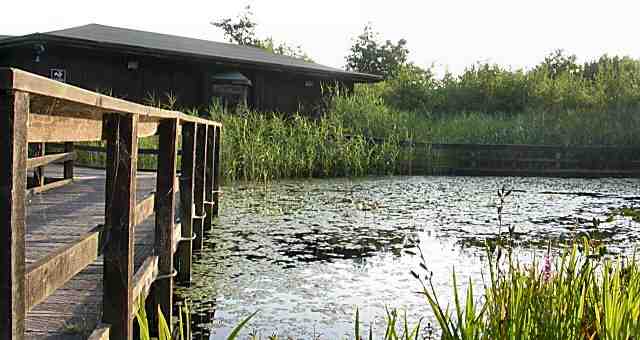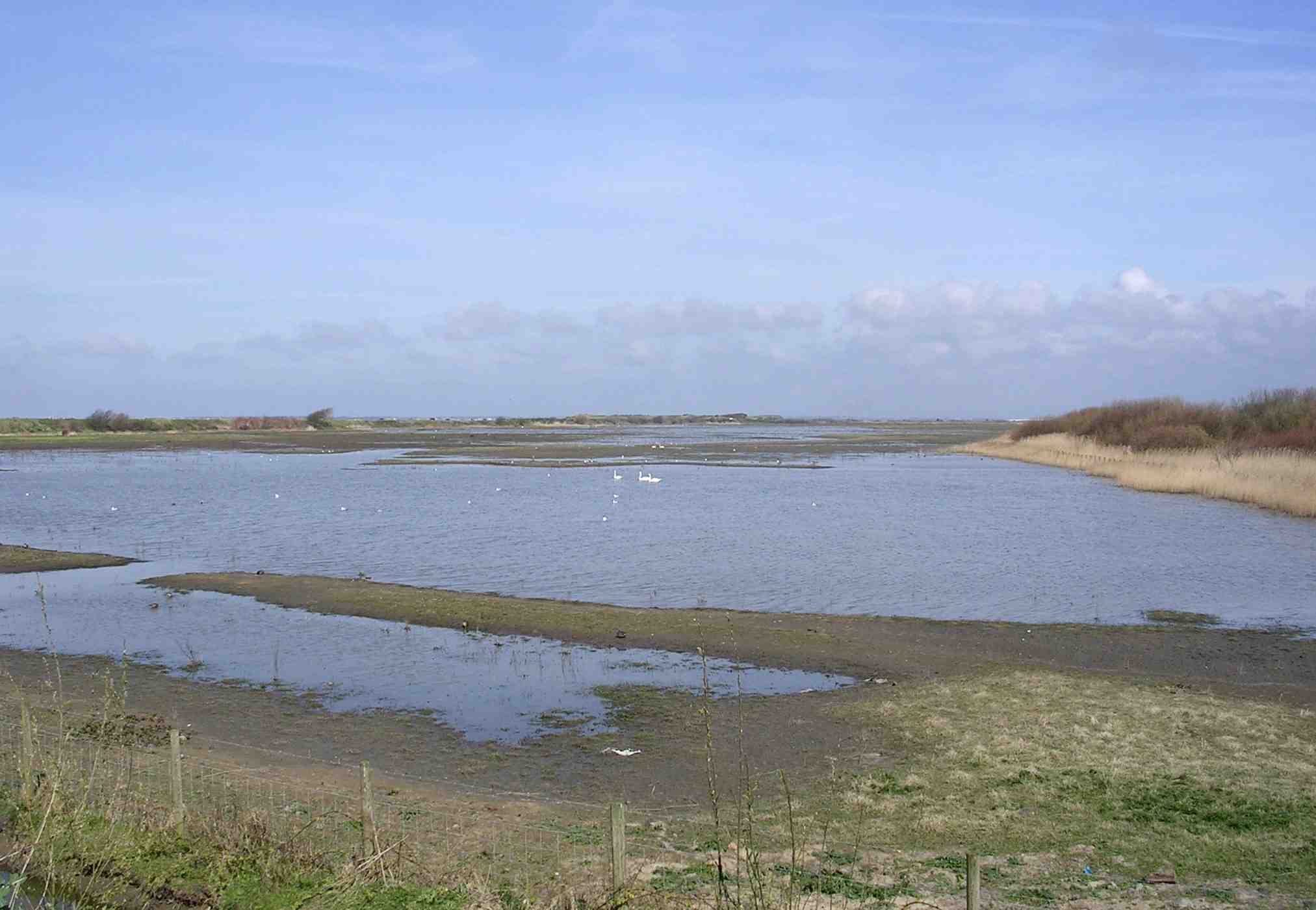Moody Mere Sands
Getting up at the crack of dawn is all well and good at the weekend but when arriving at ones appointed destination to be met by unexpected rain is nothing less than a pain in the proverbials (otherwise known as a ball ache). Imagine our disgust at setting out from the car, in cloudy skies, to be met seconds later by a rain storm that really put me in a foul mood and had me ranting and raving about the unfairness of it all. My lasses, unimpressed by my gob work, made good haste to the Rufford hide and I dawdled at the back wondering whether or not to write the whole bloody day off and sod off home. Daft really and after much self pity and bottom lip protruding (silly sod I know) I caught up with my wife and daughter, offered apologies and went into the aforementioned hide.

Mere Sands Wood - the ever welcoming visitor centre
So into the Rufford Hide and what is all the fiddling fuss about? Well, recent news from Mere Sands Wood has been of a brace of obliging Bittern (Botaurus stellaris) frequenting the local reedbeds and apparently showing really well. I had heard all this before and what one man considers to be 'showing well' another man may question. The Bittern is renowned for being a secretive blighter and so it was with little hope that we scanned the buff stands of Reed (Phragmites sp.) that occasionally quivered and thus raised the expectation levels. Besides the tall, seemingly lifeless vegetation, appreciation was had of that long lean killing machine known as the Grey Heron (Ardea cinerea), who stood proud, with neck elongated and beady eye surveying all. What a stunner! A few minutes passed and suddenly that familiar murmur was borne where a fellow spotter had seen something that made him utter the fateful name of the bird everyone was waiting to see. All bins were raised in unison but I still had little confidence of a feathered connection - what a Doubting Thomas I am! Within 40 feet there, for all to see, was the surreptitious form of the glorious Bittern - creeping along with beady eye scanning the floor in the hope of discovering a tasty morsel or two. Occasionally this beautifully camouflaged bird paused and stretched its head up high and seemingly took in the immediate surroundings although this stance is adopted when the bird is frightened. The plumage is an ideal mix of buffs, browns and black which make it virtually impossible to pick out. I like the birds alternative name, The Reed Lizard, with its slow movements and reptilian expression it seems most apt.
After leaving the dark confines of the hide it was nice to be back out beneath the brightening skies with the sun now making an effort to break through and dapple the woodland floor. We had decided to walk to the farthest feeding area and then turn back and head through the coniferous woodland so as to maximise the birding potential. Treecreepers (Certhia familiaris) crawled up the roughened trunks of Oak (Quercus sp), Dunnocks (Prunella modularis) whizzed about here and there with dubious couplings going on, Nuthatches (Sitta europea) visited the food table along with Chaffinch (Fringilla coelebs), Great Tit (Parus major) and the odd Robin (Erithacus rubecula) whilst Goldfinches (Carduelis carduelis)
tinkled to one another in the still sparse canopy where a single Great Spotted Woodpecker (Dendrocopos major) flitted from branch to branch in the hope, it seemed, of finding an ideal drumming spot. Whilst walking back some impressive shelves of Lumpy Bracket (Trametes gibbosa) were seen growing from an old Beech (Fagus sp.) log, each fungal surface wonderfully uneven and covered in a green algae that is a reliable feature of this growth.
Time is always taken at Mere Sands Wood on the corner where the barn is found as I find this the most tranquil spot and, the most satisfying. The way it juts out onto the nearby farmland gives a view that is quintessential of the area with open fields at their best when doused in sunshine. Quite often views are had of the secretive Red Legged Partridge (Alectoris rufa), jangling Corn Buntings (Emberiza calandra) - the very epitome of the LBJ (Little Brown Job that is), ground feeding Lapwing (Vanellus vanellus) and Wood Pigeon (Columba palumbus). Today the crunch of the Beech leaves beneath my clod hopping feet disturbed a pair of sheltering Stock Doves (Columba oenas) from the barn who duly flew around in a couple of circles before landing on the bare ground to begin feeding without a care in the world. If these two beauties where in the act of canoodling in the confines of the barn then it surely must have contributed to the birds appetites because no sooner had they landed than they both set about feeding away like mad and getting those crops fit to burst. Note made - fornication leads to food leads to overweight leads to no fornication - watching the calories is the key!
Through the Pine Woods we went on our way back to the visitor centre with a quick spring in the step. A few dried up fungi and a male Goldeneye (Bucephala clangula) was all that was added to the list and so, after a toilet break and a generous 'hello' to a familiar staff member we ended the trip by popping in the Lancaster Hide at the rear of the visitor centre. We didn't expect much so the strutting Water Rail (Rallus aquaticus) that came out in front of the hide and was duly spotted by my eagle eyed daughter was a pleasurable bonus to say the least. A Water Rail on any day list is as good an added extra as you can get and this little chap gave quality views despite nipping back in the reeds now and again after several slight shuffles from other frequenters of the hide. With its slate blue body, chestnut brown and black back, black-and-white barred flanks and a long red bill you would wonder how this bird stays so well hidden. What a cracker it is though and when seen make the most of it - you can go quite a few years and not see one of these avian marvels. Out through the centre and back to the car but not before paying homage to a fine collection of Tree Sparrows (Passer montanus) who absolutely radiated with fine health and chirpy pre-breeding season vitality. The Tree Sparrow is a declining bird and what an absolute loss it would be from the native fauna if this loquacious gem were to disappear from our shores. Similar in appearance to the more familiar (but also declining) House Sparrow (Passer domesticus) this smart little bird is cleaner cut and more 'scrubbed up' I suppose. With his stronger markings and chocolate brown cap he really is a dapper dude.
In the car and coffee was supped down with eagerness and thoughts turned to Marshside RSPB, our proposed second site to visit on the day. Lo and behold though my eye caught a cluster of dudes who looked familiar and it did indeed turn out to be a few acquaintances from the local area who have joined me on a walk or two in the past - be rude not to say hello wouldn't it. Nipping out and joining up with them greetings were given and we strolled down to the Marshall Hide discussing what the year had brought thus far. My wife joined us and a good twenty minutes jaw-wagging was enjoyed with plans to meet up soon registered and to be duly dealt with. Salutations, back to the car and off we went - yes - another good un' at Mere Sands Wood.
Marshside RSPB
Due to the current build up of hormones and physical irritation that my struggling daughter voiced, quite doggedly, that with a bad head, bad guts and a sore back the walk around the full circumference of this reserve would be a little too much. The options were - our young lass goes back to the car and sit it out, which she said she didn't mind, or we just have a quick flourish with the optics and cut our losses and call it a day. Enthusiasm is a bugger to curb and I really wanted to carry on until the sun did set but I know when I am beat and leaving my lass in the car whilst me and my missus wandered would be a trifle selfish and so...it was a quick trip to the main hide and a peep through the viewing screen.

Marshside RSPB - if you have the time a good old wander around the full length of the reserve is often rewarding
As the sun shone with some might the breeze from across the sands kept temperatures on the low side and just maybe we had been forced into making a good decision. The pick of the birds today were the returning Avocets (Recurvirostra avosetta) that busily fed with such industry and focus, a flock of swirling Golden Plover (Pluvialis apricaria) who caught the light just right and alternately flashed both upper and lower wings whilst surrounded by clear blues skies and a few Pintail, the best of which was a low flyer who displayed an easy to grasp jizz especially with the needle sharp tail at the rear. Little Egrets (Egretta garzetta) were plentiful on the coastal Marshes and distant Gulls offered promise of something quite rare in their midst.
The main attraction today though were a couple of Brown Hares (Lepus europaeus) who ambled around on the open grassland and had a 'full of feisty beans' look that would surely cause a bit of pugilistic fun over the coming weeks. The boxing fun is apparently unreceptive females fending off passionate males (the dirty buggers). An extra fact to take note of is the speed these long limbed critters can reach - up to 45 mph - wow - that is moving some.
So that was it for today - the only complaint being it wasn't longer. After an initial hiccup the HT road crew got back on-line and although the end was premature the natural world keeps us entertained no end.